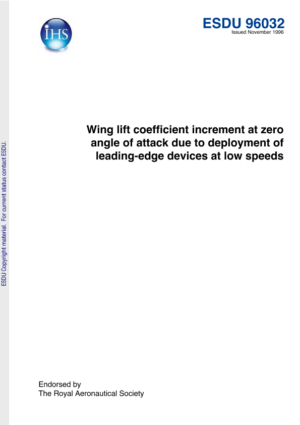ESDU 96032:1996
$89.05
Wing lift coefficient increment at zero angle of attack due to deployment of leading-edge devices at low speeds
| Published By | Publication Date | Number of Pages |
| ESDU | 1996-11-01 | 24 |
ESDU 96032 provides an empirical method developed from that for aerofoil sections in ESDU 94027 to 94031. It applies to leading-edge flaps, drooped leading edges, slats and vented Krueger flaps, and sealed slats and Krueger flaps. For wings with full-span leading-edge devices a factor, dependent on planform geometry, is applied to allow for three-dimensional effects. For part-span leading-edge devices, additional factors are introduced dependent on the device and wing geometry. The method applies for leading-edge sweep less than 47 degrees and Reynolds numbers based on aerodynamic mean chord greater than 0.6E-6. The experimental data are predicted to within 0.02 in lift coefficient based on wing area. A worked example illustrates the use of the data.











